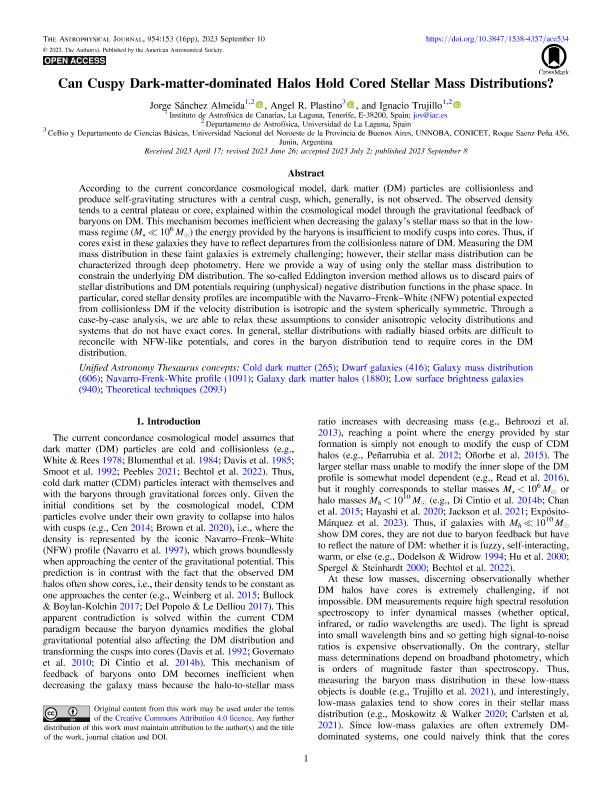Mostrar el registro sencillo del ítem
dc.contributor.author
Sánchez Almeida, Jorge
dc.contributor.author
Plastino, Ángel Ricardo

dc.contributor.author
Trujillo, Ignacio
dc.date.available
2023-12-15T16:05:36Z
dc.date.issued
2023-09
dc.identifier.citation
Sánchez Almeida, Jorge; Plastino, Ángel Ricardo; Trujillo, Ignacio; Can Cuspy Dark-matter-dominated Halos Hold Cored Stellar Mass Distributions?; IOP Publishing; Astrophysical Journal; 954; 2; 9-2023; 1-16
dc.identifier.issn
0004-637X
dc.identifier.uri
http://hdl.handle.net/11336/220477
dc.description.abstract
According to the current concordance cosmological model, dark matter (DM) particles are collisionless and produce self-gravitating structures with a central cusp, which, generally, is not observed. The observed density tends to a central plateau or core, explained within the cosmological model through the gravitational feedback of baryons on DM. This mechanism becomes inefficient when decreasing the galaxy’s stellar mass so that in the low-mass regime (M ⋆ ≪ 106 M ⊙) the energy provided by the baryons is insufficient to modify cusps into cores. Thus, if cores exist in these galaxies they have to reflect departures from the collisionless nature of DM. Measuring the DM mass distribution in these faint galaxies is extremely challenging; however, their stellar mass distribution can be characterized through deep photometry. Here we provide a way of using only the stellar mass distribution to constrain the underlying DM distribution. The so-called Eddington inversion method allows us to discard pairs of stellar distributions and DM potentials requiring (unphysical) negative distribution functions in the phase space. In particular, cored stellar density profiles are incompatible with the Navarro-Frenk-White (NFW) potential expected from collisionless DM if the velocity distribution is isotropic and the system spherically symmetric. Through a case-by-case analysis, we are able to relax these assumptions to consider anisotropic velocity distributions and systems that do not have exact cores. In general, stellar distributions with radially biased orbits are difficult to reconcile with NFW-like potentials, and cores in the baryon distribution tend to require cores in the DM distribution.
dc.format
application/pdf
dc.language.iso
eng
dc.publisher
IOP Publishing

dc.rights
info:eu-repo/semantics/openAccess
dc.rights.uri
https://creativecommons.org/licenses/by/2.5/ar/
dc.subject
Cold dark matter
dc.subject
Dwarf galaxies
dc.subject
Navarro-Frenk-White profile
dc.subject
Galaxies dark matter halos
dc.subject.classification
Astronomía

dc.subject.classification
Ciencias Físicas

dc.subject.classification
CIENCIAS NATURALES Y EXACTAS

dc.subject.classification
Otras Ciencias Físicas

dc.subject.classification
Ciencias Físicas

dc.subject.classification
CIENCIAS NATURALES Y EXACTAS

dc.title
Can Cuspy Dark-matter-dominated Halos Hold Cored Stellar Mass Distributions?
dc.type
info:eu-repo/semantics/article
dc.type
info:ar-repo/semantics/artículo
dc.type
info:eu-repo/semantics/publishedVersion
dc.date.updated
2023-12-14T12:45:57Z
dc.journal.volume
954
dc.journal.number
2
dc.journal.pagination
1-16
dc.journal.pais
Reino Unido

dc.journal.ciudad
Londres
dc.description.fil
Fil: Sánchez Almeida, Jorge. Instituto Astrofisico de Canarias; España. Universidad de La Laguna; España
dc.description.fil
Fil: Plastino, Ángel Ricardo. Consejo Nacional de Investigaciones Científicas y Técnicas; Argentina. Universidad Nacional del Noroeste de la Provincia de Buenos Aires; Argentina
dc.description.fil
Fil: Trujillo, Ignacio. Instituto Astrofisico de Canarias; España. Universidad de La Laguna; España
dc.journal.title
Astrophysical Journal

dc.relation.alternativeid
info:eu-repo/semantics/altIdentifier/url/https://iopscience.iop.org/article/10.3847/1538-4357/ace534
dc.relation.alternativeid
info:eu-repo/semantics/altIdentifier/doi/http://dx.doi.org/10.3847/1538-4357/ace534
Archivos asociados
